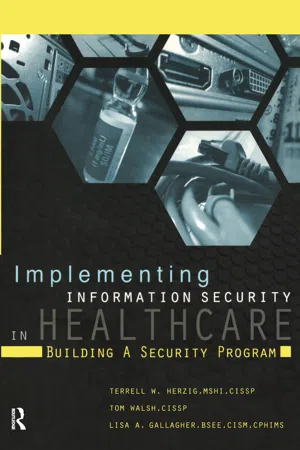
Implementing Information Security in Healthcare
Building a Security Program
- 312 pages
- English
- ePUB (mobile friendly)
- Available on iOS & Android
About this book
Implementing Information Security in Healthcare: Building a Security Program offers a critical and comprehensive look at healthcare security concerns in an era of powerful computer technology, increased mobility, and complex regulations designed to protect personal information. Featuring perspectives from more than two dozen security experts, the book explores the tools and policies healthcare organizations need to build an effective and compliant security program.
Topics include information security frameworks, risk analysis, senior management oversight and involvement, regulations, security policy development, access control, network security, encryption, mobile device management, disaster recovery, and more. Information security is a concept that has never been more important to healthcare as it is today. Special features include appendices outlining potential impacts of security objectives, technical security features by regulatory bodies (FISMA, HIPAA, PCI DSS and ISO 27000), common technical security features, and a sample risk rating chart.
Frequently asked questions
- Essential is ideal for learners and professionals who enjoy exploring a wide range of subjects. Access the Essential Library with 800,000+ trusted titles and best-sellers across business, personal growth, and the humanities. Includes unlimited reading time and Standard Read Aloud voice.
- Complete: Perfect for advanced learners and researchers needing full, unrestricted access. Unlock 1.4M+ books across hundreds of subjects, including academic and specialized titles. The Complete Plan also includes advanced features like Premium Read Aloud and Research Assistant.
Please note we cannot support devices running on iOS 13 and Android 7 or earlier. Learn more about using the app.
Information
Chapter 1
The Importance of Information Security in Healthcare
- Can others scan our systems from the Internet?
- Do we authenticate with passwords?
- Do we keep our systems up-to-date?
- Do we understand how our systems can be exploited?
- Do we monitor our systems for attacks?
- Do we provide a safe work environment for our employees?
- Do we provide a safe environment in which to treat our patients?
Table of contents
- Cover
- Title Page
- Copyright Page
- About the Editors
- About the Contributors
- Table of Contents
- Acknowledgments
- A Tribute to Terrell W. Herzig
- Chapter 1: The Importance of Information Security in Healthcare
- Chapter 2: Information Security Frameworks
- Chapter 3: Information Security Planning
- Chapter 4: Risk Analysis
- Chapter 5: Senior Management Oversight and Involvement
- Chapter 6: Information Security Regulations
- Chapter 7: Security Policy Development
- Chapter 8: The Concept of Security Controls
- Chapter 9: Access Control
- Chapter 10: Network Security
- Chapter 11: Use of Encryption
- Chapter 12: Managing Mobile Devices
- Chapter 13: Application Security
- Chapter 14: Information Security Operations
- Chapter 15: Security Considerations in Technology Contracting
- Chapter 16: Business Continuity and Disaster Recovery
- Chapter 17: Change Control and Change Management
- Chapter 18: Testing Your Technical Controls
- Chapter 19: Auditing Your Program
- Chapter 20: Incident Handling
- Chapter 21: Information Systems Implementation
- Appendix A
- Appendix B
- Index